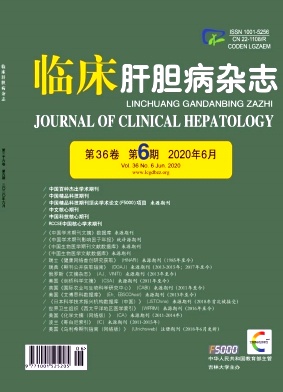|
[1] CHA JY,KIM DH,CHUN KH. The role of hepatic macrophages in nonalcoholic fatty liver disease and nonalcoholic steatohepatitis[J]. Lab Anim Res,2018,34(4):133-139.
|
|
[2] ABDULLAH Z,KNOLLE PA. Liver macrophages in healthy and diseased liver[J]. Pflugers Arch,2017,469(3-4):553-560.
|
|
[3] WANG LX,ZHANG SX,WU HJ,et al. M2b macrophage polarization and its roles in diseases[J]. J Leukoc Biol,2019,106(2):345-358.
|
|
[4] BAECK C,WEHR A,KARLMARK KR,et al. Pharmacological inhibition of the chemokine CCL2(MCP-1)diminishes liver macrophage infiltration and steatohepatitis in chronic hepatic injury[J]. Gut,2012,61(3):416-426.
|
|
[5] van der HEIDE D,WEISKIRCHEN R,BANSAL R. Therapeutic targeting of hepatic macrophages for the treatment of liver diseases[J]. Front Immunol,2019,10:2852.
|
|
[6] CARPINO G,del BEN M,PASTORI D,et al. Increased liver localization of lipopolysaccharides in human and experimental non-alcoholic fatty liver disease[J]. Hepatology,2019.[Online ahead of print]
|
|
[7] KRENKEL O,HUNDERTMARK J,ABDALLAH AT,et al. Myeloid cells in liver and bone marrow acquire a functionally distinct inflammatory phenotype during obesity-related steatohepatitis[J]. Gut,2020,69(3):551-563.
|
|
[8] XIONG X,KUANG H,ANSARI S,et al. Landscape of intercellular crosstalk in healthy and NASH liver revealed by singlecell secretome gene analysis[J]. Mol Cell,2019,75(3):644-660. e5.
|
|
[9] LI L,WEI W,LI Z,et al. The spleen promotes the secretion of CCL2 and supports an M1 dominant phenotype in hepatic macrophages during liver fibrosis[J]. Cell Physiol Biochem,2018,51(2):557-574.
|
|
[10] LOOMBA R,LAWITZ E,MANTRY PS,et al. GS-4997,an inhibitor of apoptosis signal-regulating kinase(ASK1),alone or in combination with simtuzumab for the treatment of nonalcoholic steatohepatitis(NASH):A randomized,phase 2 trial[J]. Hepatology,2016,64(Suppl):1119A-1120A.
|
|
[11] GUAL P,GILGENKRANTZ H,LOTERSZTAJN S. Autophagy in chronic liver diseases:The two faces of Janus[J]. Am J Physiol Cell Physiol,2017,312(3):C263-C273.
|
|
[12] DUITS D,WELLENSTEIN MD,de VISSER KE. In vitro assessment of cancer cell-induced polarization of macrophages[J]. Methods Enzymol,2020,632:133-154.
|
|
[13] YAO RR,LI JH,ZHANG R,et al. M2-polarized tumor-associated macrophages facilitated migration and epithelialmesenchymal transition of HCC cells via the TLR4/STAT3 signaling pathway[J]. World J Surg Oncol,2018,16(1):9.
|
|
[14] LI X,YAO W,YUAN Y,et al. Targeting of tumour-infiltrating macrophages via CCL2/CCR2 signalling as a therapeutic strategy against hepatocellular carcinoma[J]. Gut,2017,66(1):157-167.
|
|
[15] PIERANTONELLI L,RYCHLICKI C,AGOSTINELLI L,et al. Lack of NLRP3-inflammasome leads to gut-liver axis derangement,gut dysbiosis and a worsened phenotype in a mouse model of NAFLD[J]. Sci Rep,2017,7(1):12200.
|
|
[16] WANG Q,WEI S,ZHOU S,et al. Hyperglycemia aggravates acute liver injury by promoting liver-resident macrophage NLRP3 inflammasome activation via the inhibition of AMPK/mTOR-mediated autophagy induction[J]. Immunol Cell Biol,2020,98(1):54-66.
|
|
[17] LOOMBA R,LAWITZ E,MANTRY PS,et al. The ASK1 inhibitor selonsertib in patients with nonalcoholic steatohepatitis:A randomized,phase 2 trial[J]. Hepatology,2018,67(2):549-559.
|
|
[18] MARADANA MR,YEKOLLU SK,ZENG B,et al. Immunomodulatory liposomes targeting liver macrophages arrest progression of nonalcoholic steatohepatitis[J]. Metabolism,2018,78:80-94.
|
|
[19] FREUND B,HEEREN J,NIELSEN P,et al. Nanoparticle compositions for generation of regulatory T cells and treatment of autoimmune diseases and other chronic inflammatory conditions[EB/OL]. http://www. freepatentsonline. com/y2018/0325821. html.
|
|
[20] KURNIAWAN DW,JAJORIYA AK,DHAWAN G,et al. Therapeutic inhibition of spleen tyrosine kinase in inflammatory macrophages using PLGA nanoparticles for the treatment of nonalcoholic steatohepatitis[J]. J Control Release,2018,288:227-238.
|
|
[21] YU Y,LIU Y,AN W,et al. STING-mediated inflammation in Kupffer cells contributes to progression of nonalcoholic steatohepatitis[J]. J Clin Invest,2019,129(2):546-555.
|
|
[22] MASS E. Delineating the origins,developmental programs and homeostatic functions of tissue-resident macrophages[J]. Int Immunol,2018,30(11):493-501.
|
|
[23] STUTCHFIELD BM,ANTOINE DJ,MACKINNON AC,et al.CSF1 restores innate immunity after liver injury in mice and serum levels indicate outcomes of patients with acute liver failure[J]. Gastroenterology,2015,149(7):1896-1909. e14.
|
|
[24] VONGHIA L,van HERCK MA,WEYLER J,et al. Targeting myeloid-derived cells:New frontiers in the treatment of non-alcoholic and alcoholic liver disease[J]. Front Immunol,2019,10:563.
|
|
[25] WANG B,LI Q,QIN L,et al. Transition of tumor-associated macrophages from MHC class II(hi)to MHC class II(low)mediates tumor progression in mice[J]. BMC Immunol,2011,12:43.
|
|
[26] ZHENG F,SPARKES A,de BAETSELIER P,et al. Molecular imaging with Kupffer cell-targeting nanobodies for diagnosis and prognosis in mouse models of liver pathogenesis[J]. Mol Imaging Biol,2017,19(1):49-58.
|
|
[27] FANTUZZI L,TAGLIAMONTE M,GAUZZI MC,et al. Dual CCR5/CCR2 targeting:Opportunities for the cure of complex disorders[J]. Cell Mol Life Sci,2019,76(24):4869-4886.
|
|
[28] AO JY,ZHU XD,CHAI ZT,et al. Colony-stimulating factor 1receptor blockade inhibits tumor growth by altering the polarization of tumor-associated macrophages in hepatocellular carcinoma[J]. Mol Cancer Ther,2017,16(8):1544-1554.
|
|
[29] FANG P,XIANG L,HUANG S,et al. IRE1α-XBP1 signaling pathway regulates IL-6 expression and promotes progression of hepatocellular carcinoma[J]. Oncol Lett,2018,16(4):4729-4736.
|
|
[30] FERNNDEZ-VARO G,PERRAMN M,CARVAJAL S,et al.Bespoken nanoceria:A new effective treatment in experimental hepatocellular carcinoma[J]. Hepatology,2020.[Online ahead of print]
|
|
[31] MA HY,YAMAMOTO G,XU J,et al. IL-17 signaling in steatotic hepatocytes and macrophages promotes hepatocellular carcinoma in alcohol-related liver disease[J]. J Hepatol,2019.[Online ahead of print]
|
|
[32] GOMES AL,TEIJEIRO A,BURN S,et al. Metabolic inflammation-associated IL-17A causes non-alcoholic steatohepatitis and hepatocellular carcinoma[J]. Cancer Cell,2016,30(1):161-175.
|
|
[33] FOGLIA B,SUTTI S,PEDICINI D,et al. Oncostatin M,a profibrogenic mediator overexpressed in non-alcoholic fatty liver disease,stimulates migration of hepatic myofibroblasts[J].Cells,2019,9(1):28.
|
|
[34] DONG B,ZHOU Y,WANG W,et al. Vitamin D receptor activation in liver macrophages ameliorates hepatic inflammation,steatosis,and insulin resistance in mice[J]. Hepatology,2019.[Online ahead of print]
|
|
[35] SONG K,KWON H,HAN C,et al. Yes-associated protein in Kupffer cells enhances the production of proinflammatory cytokines and promotes the development of nonalcoholic steatohepatitis[J]. Hepatology,2019.[Online ahead of print]
|







 DownLoad:
DownLoad: